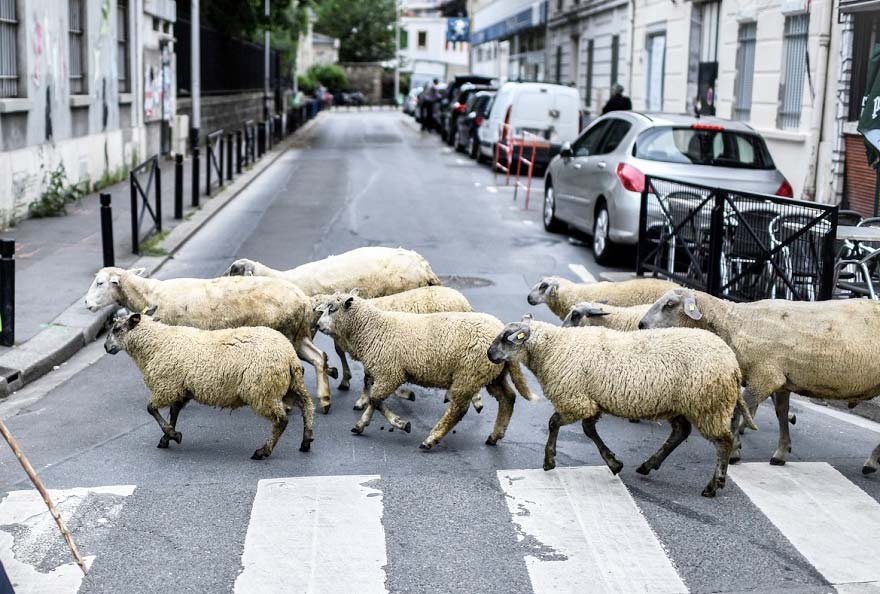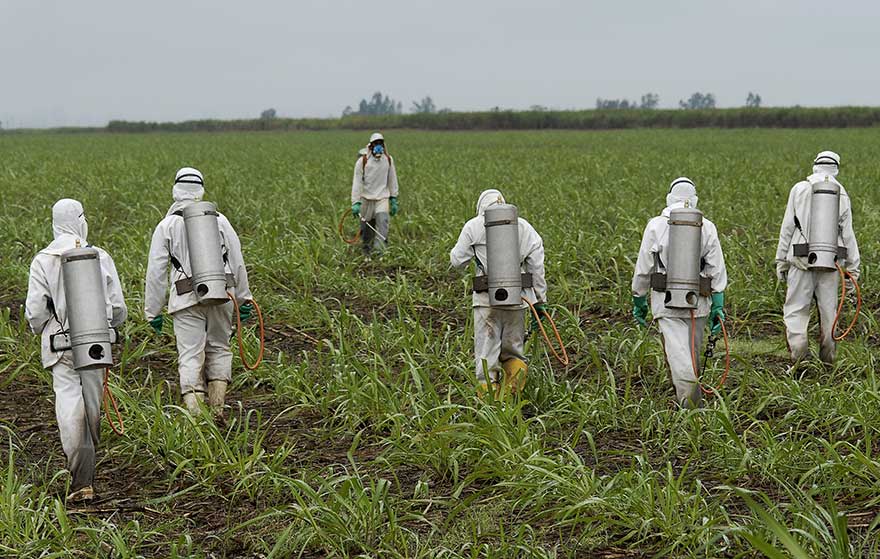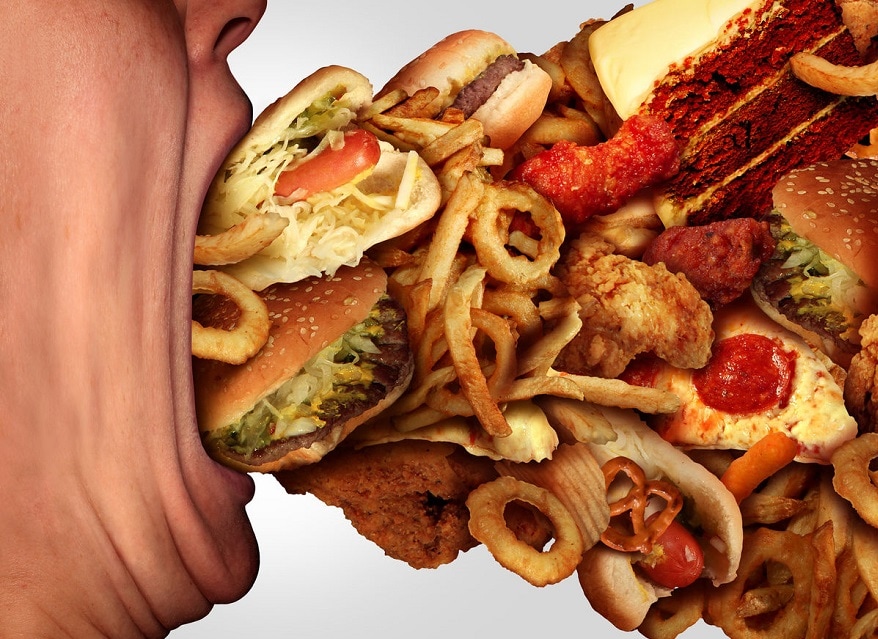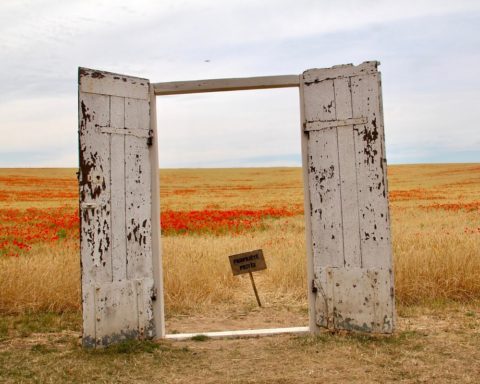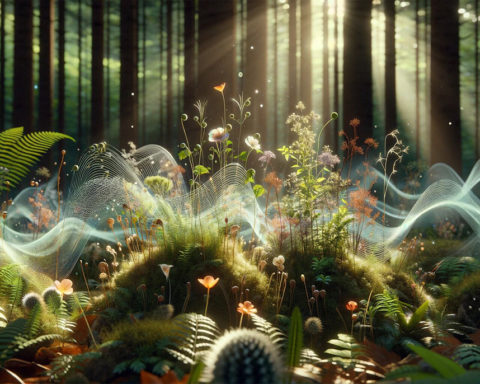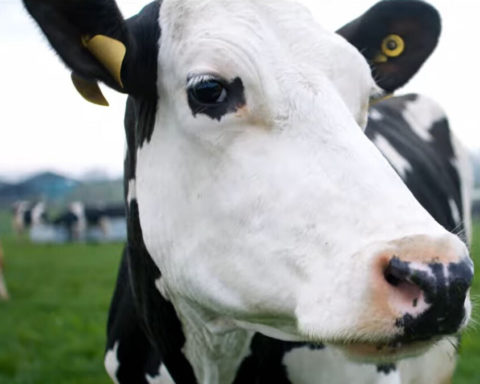Shocked by the environmental crisis and concerned about their food and health, the inhabitants of the metropolis are once again considering agriculture. But the ideal vision they have retained of it is difficult to project in the face of the organization and practices of the contemporary city. The "Agricultural Capital - Building Sites for a Cultivated City" event will explore the qualitative links between agricultural production and urban production, between the cultivated and the inhabited, between the city and the soil, until January 27, 2019.
Puring three months, "Capital agricole - Chantiers pour une ville cultivée", a plural and diverse event for all audiences, will be held in conjunction with the exhibition and the accompanying book, and will feature numerous events and meetings to share and discover this fundamental issue of agriculture. In November and December, the Pavillon de l'Arsenal, in partnership with La Ruche qui dit oui! and MiiMOSA, will install for the first time, in the heart of its main hall and exhibition spaces, the Pavillon de l'Arsenal Pavilion, in partnership with MiiMOSA, the online platform MiiMOSA, an event that is plural, diverse and intended for all audiences, a peasant market which brings together a selection of Ile-de-France farmers and producers. Market gardeners, cheese makers, butchers, fishmongers, bakers, beekeepers..., come and visit the "Agricultural Capital" exhibition while doing your market of Ile-de-France products, organic or sustainable agriculture.
The urban planning undertaken since the end of the Second World War, prioritizing the relationship between the Urban, Nature and Agriculture, has led to the current environmental impasse. It has also wiped out the exceptional Ile-de-France agricultural heritage of the late 19th century, led by "specialist" farmers inventing other crops to feed Paris while preserving the fauna and flora. It is on this forgotten urban agriculture, rehabilitated in the exhibition, that architects, town planners, farmers, ecologists, engineers, entrepreneurs, historians, geographers, sociologists..., gathered around the SOA architecture agency, Augustin Rosenstiehl, are now basing themselves to envisage new hybrid models.
Some pioneers are already investing the roofs of neighbourhoods or the basements of buildings, crossing the territory on transhumance or animating peri-urban farms, ... while others are planning for tomorrow to cultivate business parks, to invest in the agronomic potential of large housing estates, to forage parks and even the sides of motorways. At the heart of this agricultural reconquest, the farm is reinventing itself as the point of inking and exchange between the farmer and the city dweller. All of the actions propose a coherent collective vision and invent an urban form that simultaneously involves land and places, trades and tools, human and living beings.
In a chronological and thematic progression, the "Agricultural Capital" exhibition guides the visitor through the discovery of the history and future of agriculture in the Ile-de-France region. Period photographs and video archives by the architects who conceived the great utopias of development are complemented by an original cartography of the metropolis, original drawings by Yann Kebbi on the evolution of the tools and habitats of the farming world, photographic and audio portraits by the artist Sylvain Gouraud of seven pioneers of metropolitan agriculture, and the landscape of building sites for a cultivated city.
Forward-looking and committed, the Capital agricole event reveals the primary links between town, nature and agriculture, because beyond their opposition lie the keys to a new Agricultural Urbanism.
Agricultural capital,
according to Augustin ROSENSTIEHL / SOA - Architect, guest scientific commissioner
Our entry into the third millennium is an ecological challenge. The environmental crisis that we are experiencing not only tests our enthusiasm and hope to bequeath to future generations a world that is simply habitable, but also shakes the belief that we are collectively doing everything we can to make it happen. On one side there are those who herald the end of our civilization and, at the opposite extreme, those who have chosen to be in denial and propose to continue doing business as usual. Between the two, the competent international scientific community agrees that human activity has a strong impact on the balance of the planet. If we are capable of upsetting the earth's equilibrium (for example that of submerged soils, more than half of which are degraded1 by our activities), perhaps we are in a position to help restore it?
One thing is certain: no matter what we do, our actions are now having an impact on a large scale! The same scale that modern urban planning addresses and which goes far beyond the city to finally develop all the functions on the territory: developing the Urban and its activities, but also Agriculture and Nature.
In the face of the ecological crisis, there seems to be a tacit consensus to defend the idea of an urbanism closer to Nature that would produce green cities, as if engaging in a kind of fusion between the Urban and Nature was a solution to regain a sustainable balance. But do we only have the right cards in hand to act?
Are Urban, Nature and Agriculture, as bequeathed to us by the 20th century, capable of getting us out of this crisis? Don't each of these concepts need to be rethought today?
- Isn't it necessary to go beyond the foundations of modern urban planning, which everywhere translates into a functional separation - here housing, there industry, here agriculture, there nature, here shops, there offices -, to better interweave these functions with each other?
- What is this Nature to which it would suddenly be so crucial to make room among our constructions to stop the massive fall of the living? Is it that of green spaces, lawns, flowerbeds or vegetalized walls, this Nature of leisure and ornamentation? Or should we retrocede part of our territory to a wild Nature that would be freed from our presence?
- Has today's agriculture, which we demand maximum food production but which we practise far from any collective life and which we recognize as one of the most polluting sectors of activity, become alien to Nature?
The book Agricultural Capital proposes to explore these questions in greater depth by observing the city, its history and its future through the prism of agriculture. If the challenge of our future lies in a better cohabitation of the living within our multiple activities, it seems that we must rewind the Ariadne's thread, retrace our steps and explore a new direction. If we look at the specific case of the Île-de-France region and observe the changes in the rights-of-way of the city, crops and nature over the last century, we can see that, unsurprisingly, half of the agricultural land has been lost. But much more surprising is the considerable increase in Nature areas. For if their influence has almost doubled in a hundred years, how can we explain that we are witnessing such a fall in biomass and biodiversity in the same period of time? What then is this Nature whose influence is increasing and whose substance is decreasing? Where did the fauna and flora live a century ago, in this territory that was essentially cultivated? Should we look in the perimeter of forest areas, in the fields, in the city, or simply in the complex architecture of their interweaving?
Should we consider the half a million Ile-de-France peasants who shaped the entire territory, cultivated, built, and regulated life, and who today are only five thousand, busy producing mass food?
The states of PROMISCUITY in the past, ZONING in the past and FACE-À-FACE in the present highlight the way in which Agriculture has been cut off, in the space of only three generations, from its close relationship with Nature and its regulating function of living things, while its actors, architecture and landscapes have been committed outside the ideal destiny of the city, outside the urbanity. By restricting the agricultural world to an exclusive function of food production, have we not lost an essential function in passing: the art of transforming Nature, of shaping inhabitable landscapes in such a way as to feed on it while ensuring that our roommates, fauna and flora, remain there?
In parallel with this historical mutation of the modern world towards a global reality, many pioneering architects have taken up the agricultural question to reshuffle the maps and propose other world projects as utopias.
Finally, since the new climate order and the issue of access to land for all now invite us to a new form of sharing, it is collectively that we need to enhance the value of the metropolis and the Ile-de-France agricultural world taken together. On the basis of multidisciplinary work, farmers, architects, artists, developers, entrepreneurs, beekeepers and ecologists are proposing a change of viewpoint on the territory, moving from zoning and regulatory mapping prescriptions to a set of worksites that address existing neighbourhoods and cultivated areas according to their specific features and the potential of their soils.
The construction site of such an agricultural metropolis is envisaged through new sectors, some of them embryonic, crossing the professions of agriculture and urban planning, as a new way of shaping the landscape, architecture and its programming: starting from existing farms and those to be created, a network of new civic centralities is being structured on a metropolitan scale. Rather than "naturalizing society", it is a question of broadening the horizon of our life and our world, "experimenting with new ways to make new forms of life exist, seeking more life (2) ». Helping to re-establish the innumerable scattered locations in the Paris urban area, restoring strength to the soils of Île-de-France and enhancing the attractiveness of its landscapes. (3)This is the ambition of Capital Agricole, which for this reason unearths the essential link between the "inhabited" and the "cultivated", and takes us towards AGRICULTURAL URBANISM.
1. See Simon Roger, "La moitié des terres dans le monde sont dégradées", Le Monde, 4 July 2018. 2. As Serge Moscovici invites us to do through his works devoted to the human dimension of nature, here in Réenchanter la nature. Interviews with Pascal Dibie, La Tour-d'Aigues, Éditions de l'Aube, 2002.
3. While Ile-de-France residents own just over 30% of the country's second homes, there are only 13,000 single-family second homes in the Ile-de-France region, or one in one hundred and forty-five in France. Source Insee, SOeS, Annual estimate of the housing stock as of 1 January 2016.
The encounter between city and country is not a new issue. In 1873, the writer Edmond About already said about the transformation of lifestyles in his time: "You introduce the countryside into the dwellings of the city, and you urbanize the surroundings, the habits, the very labour of the country man. "Even before the Industrial Revolution, Paris and most of the large European cities had developed where there was fertile land and organized agriculture. Thus, if we are accustomed to opposing them, city and countryside are far from being the homogeneous and perfectly partitioned territories that the collective imagination, nourished by fine arts and literature, readily imposes on us. This book and the fascinating exhibition it accompanies are intended to help us discover these ancient, multiple and varied interactions, while inviting us to reinvent the age-old pact that unites them. Today, urbanization is an undeniable phenomenon that affects the entire world. It is also a reality that is experienced at the local level, reinforced by the advent of metropolises and by the migration crisis, which is having its first effects at the gates of cities. At the same time, our planet is facing a major ecological and food challenge. Finally becoming aware that the Earth's resources are limited and that climate change poses a great danger to our future, we are questioning our ways of producing and consuming. We have a civic and political responsibility to do everything we can to bequeath to future generations a world that is respectful of life and its environment. In this changing world, the opposition between city(s) and countryside(s) no longer seems appropriate, as it leads to imbalances between territories. We need to decompartmentalize spaces, make borders more porous and increase exchanges between urban and rural areas. The preservation of agricultural land, especially on the outskirts of cities, and an understanding of the issues at stake in agriculture are essential for the future of the planet and its inhabitants. Beyond this, we must rethink the Paris metropolis as a whole in order to make it a more intelligent space: a space where biodiversity can flourish, where urban and rural areas enrich each other through new commercial and non-commercial exchanges. Short circuits, the production of renewable energies, the development of agro-materials, bio-waste or arboriculture are huge sources of employment, bridges between territories and ways to fight against the reduction of greenhouse gas emissions. Often ahead of political decisions, many alternative solutions are emerging among farmers and civil society. They aim to restore balance, meaning and roots - diversification of production, product processing, reduction of phytosanitary treatments, Amap, urban agriculture, shared gardens in cities... Our responsibility is to encourage these initiatives and facilitate their large-scale implementation, in order to return to sustainable food, promote proximity, diversity and practices that respect the environment and the health of consumers and producers. This is what we have done in Paris by committing ourselves, at the beginning of 2017, to urban agriculture that creates new links between urban and rural areas, through the deployment of vegetalisation, the "Les Parisculteurs" call for projects, the "Cultiver en ville" programme and the Sustainable Food Plan, which makes our community the leading public purchaser of organic food in France. Citizen participation is at the heart of these projects, and essential to their success. Consolidating and rethinking our agricultural system, reinventing exchanges, transforming our cities and our lives: all these challenges cannot be met without the help of those who bring our territories to life. This event succeeds in immersing us in our roots while revealing new possibilities. Tracing a little-known part of our history that continues and renews itself today, it draws the future'.Anne Hidalgo, Mayor of Paris
Utopias - Radical Visions (1930-2016)
The work of the Irish poet Thomas More, Utopia is about a society that responds to a problem that arose in England in the 16th century, the episode of the "enclosures": counties moving from a communal agricultural system to a system of private property that was detrimental to the peasant world.
It is from agriculture and its common use that the first utopia was born. Later, humanism would be at the origin of architectural utopia, this time anchored in reality. In the 19th century, Charles Fourier's phalanstery principle ensured a harmonious life for workers and their families, as in "La Colonie sociétaire", in the Yvelines, a project based on the colonisation of the land.
Then modern urban planning generates an above-ground thinking that leads to globalization. For the new utopians, the world is an architecture in itself and utopia without a place becomes a super-place. The concept of anthropocene reveals that human activity is a determining geological constraint. One ideology defends the planet as a limited container, the other as an infinite container.

For example, Frank Lloyd Wright's Broadacre City (1930) combines urban, agricultural and natural settings into a one-acre family plot in a continuum spanning the United States and setting a numerus clausus of inhabitants.

Le Corbusier's Radiant Farm (1935), optimized, partitioned and cut off from the urban world, records the place of agriculture. Similarly, the master plan New Corktown (2016) by Albert Pope and Jesús Vassallo imagines huge plots of forest interwoven between giant wooden buildings to reduce the carbon footprint of the city of tomorrow. While the Agricultural City project (1960) by Japanese architect Kisho Kurokawa superimposes the city above the fields; as do Oswald Mathias Ungers and Rem Koolhaas who, together with their collective, propose "Berlin, Green Archipelago" (1977), an infinite number of compositions interweaving agriculture and nature among the preserved islets of a city in ruins. A hybridisation that Andrea Branzi pushes to its paroxysm with Agronica (1995), a continuous device of agricultural and urban units caught in a perpetual movement. Living and cultivating are derived from the same Latin verb: anger.
Today, nature in crisis
In the face of the new environmental crisis, the modern trend is towards the sanctuarisation of nature in order to preserve it from human actions, thus dispossessing the agricultural world, which has always negotiated resources thanks to its profound knowledge of living things. Urban dwellers, now in the majority, have taken up the torch, armed with new technologies but lacking ancestral knowledge.
Luckily, outside the frame, pioneers are rebuilding lost ties. The artist Sylvain Gouraud, who has set out to meet these new landowners from the Île-de-France region, traces the interactions specific to the worlds they inhabit, thus bringing out the problems from the ground and without preconceived ideas. His intimate approach allows us to grasp the complexity of the uses of nature without going through the modern prism that opposes Nature and Culture. The concrete walls of an underground car park are ideal for growing mushrooms and the supermarket lawns are ideal for grazing sheep. While the producer/consumer model is being rethought with the Amap system, oyster mushrooms reduce soil pollution in the Parisian belt. (Ferme Sapousse in Pussay (Essonne), Ferme des Beurreries, near Versailles, Chatrelauin nurseries in LeThillay in the Val d'Oise, the Cycloponics farm in the 18e arrondissement de Paris, ...)
Women are under-represented in proportion to their investment in our resensitization to life, and I regret that I was unable to find the right words to convince them to show their place. The other pitfall comes from the fact that almost all of these proposals come up against the law. They are often tolerated by the public authorities because they are obviously socially beneficial, but they only exist because of the conviction of their authors. A long process of political negotiation, in the noble sense of the term, remains to be carried out to establish these non-structural areas likely to bring about tomorrow's solutions. To this end, actors, citizens, decision-makers... and artists must be brought to the table. »Sylvain Gouraud
Tomorrow's agricultural planning
Starting with what already exists means starting with homogeneous urban areas. Large urban areas are largely endowed with soil: can intensive agricultural activity enrich them? The uninhabited areas of activity, archidependent on the car, occupy huge stagnant spaces: can these be cultivated and dedicated to the processing of crops? Could the innumerable enclosed gardens in suburban areas, in contrast to the movement of "enclosures", offer a continuous rhizome of paths and crops? And the agricultural areas themselves, are they not likely to be suitable for housing?
The farm is the hub of this transformation. Tomorrow, it can restructure a network of neighborhoods and public spaces, connect the city to the fields and ensure fluidity between Paris and the Ile-de-France region. Its architecture and programming must appear in its form and bring together the functions of a city centre, like today's shopping centres. With this in mind, Pierre and Rémi Janin, architects, landscapers and farmers, pioneers of agricultural urban planning, show us how to rediscover the soils of Île-de-France and imagine a typology of farms, new or rehabilitated. Les Fermes de Gally, a major player in horticultural innovations, opens up cross-cutting avenues for the recovery of urban waste and the city's fatal energy, but also for its depollution, and addresses the central issue of teaching and learning. The ecologist Florent Yvert proposes to cultivate "wild" species and to think about the architecture of the habitat and animal mobility. Hugo Christy and Paul Jarquin, promoters of exclusively wooden constructions, consider the decisive forestry share in the construction of buildings and infrastructures. Finally, Olivier Darné, an artist beekeeper, recalls and discusses the essential role of the bee. In other words, all of them envisage a general access to culture!
Recovering soils
The reconsideration of the soil and the necessary attribution of an agricultural and nourishing use value commit to requalify all the spaces by paying a new attention to the places. From the intersection between urban and agricultural practices, potential emerges, with multi-functional spaces also developing complementary resources. Urban spaces then become places of exchange that accommodate modulated agriculture.
Everyone can also become a temporary, versatile farmer, invested in a common food production capacity, which allows the importance of living things to be taken into account. In peri-urban areas, agricultural activity also makes it possible to give a structuring and useful use to the residual gaps, the unused areas which, collectively, are expensive to manage and maintain. In rural areas, the ambition is to recreate an agricultural investment that is possible for everyone, thanks to places of friction developing a plural agriculture that is not only based on practices and specialized and professional actors, but also improves the versatility of the spaces.
The challenge is quite simply to achieve a nourishing metropolis that seizes its primary resource, the quality of the soil on which it is built, by recognizing its value and agricultural potential.

RECREATING SOIL Production of a variety of 4,000 aromatic plants in hydroponic cultivation on the roofs of an RATP shed, Aéromates company, Paris, 2017. Pascal Xicluna /Min.Agri.fr
Connecting for better nutrition
For the architect Pierre Janin, the agricultural use of the space of metropolitan communication networks may tomorrow give rise to a new territorial coherence, based on a principle of rhizomic and productive diffusion. Motorwaysides, abandoned roads and paths, quays and canal banks, railway wastelands, etc. are all areas and corridors to be invested and cultivated.
Points of diffusion and concentration of hybrid agriculture, installed at the intersection of flows, will structure these new agricultural areas. In order to demonstrate the presence of the networks and their dedicated areas in terms of agricultural management, the development must also be complemented by a nomadic system ensuring an identifiable status for itinerant agricultural players: metropolitan shepherds, nomadic nurseries or compost transporters.
In addition, the definition of new tools, spaces and machines specific to the operation of the networks, thought to be complementary and modular, must generate singular ephemeral places and make the renewed use of transport networks legible.

FOOD BY WATER COURSES Delivery of fruit and vegetables by the boat of the association Marché sur l'eau, which offers city dwellers the opportunity to buy fresh produce grown in Île-de-France directly. Sylvain Gouraud
The urban ideal
The post-war period began a metamorphosis of the agricultural suburbs. Put into practice under the impetus of the Charter of Athens (1933) and the thinking of the architect Le Corbusier, modern urban planning will reorganize the landscape and the lives of men. Special cultures were then considered as archaic remnants of a finite world. While some people saw in them a promising urban and agricultural model, General de Gaulle cried out: "This Parisian suburb, we don't know what it is! Get me some order in this mess! »
A first massive wave of urbanisation of large housing estates was launched around 1950 in order to solve the housing crisis and insalubrity. However, to compensate for the lack of expensive facilities, dormitory towns were accompanied by a new form of nature: green spaces. Leisure centres and other play and health areas invade whole swathes of special crops. The second wave is led by Valéry Giscard d'Estaing: "The France of owners" leads to the sudden proliferation of pavilions whose gardens, the ultimate form of nature, replace the last cultivated plots.
As early as 1962, the Common Agricultural Policy set out to make Europe the leading agricultural exporter. Ile-de-France's land is dedicated to a cereal crop for export for a global breadbasket. The policy of land consolidation led to the recasting of the many plots of land into huge fields that made mechanised work profitable. The groves, trees, hedges, troglodytes and, with them, paths, shelters, huts, houses and small farm buildings are disintegrated. In barely three generations, the episode of modern reconstruction has not only amputated the agricultural world of its regulating function of the living environment, but also of its urbanity, taking it out of the ideal destiny of the city. In 1967, the Land Orientation Law enshrined this separation by creating the regulatory zones, which are still deeply rooted in our minds today: agricultural (A), urban (U) and natural (N).
Reinventing farms
For the architect Pierre Janin, "Ile-de-France farms punctuate the common agricultural space. They are located at a distance from busy roads, but close to local roads and farm tracks that provided a link with the agricultural area, and reflect an ancient rural organisation. Generally built by the addition and aggregation of composite constructions, their typical primary structures were supplemented over the years by annex buildings. Thus, the present farmhouses are multi-functional composite ensembles, combining living quarters and agricultural premises for the storage of foodstuffs, animals and equipment.
This often little-regarded agricultural heritage has been altered and dressed up with vegetal screens often hiding it in the Ile-de-France landscape, thus breaking all links between the interior space of farms, their surroundings and the nearby fields and crops.
The result today is a kind of isolation of the farms. The evolution of agricultural practices, involving a diversification of trades and the emergence of short circuits between producers and consumers, is leading to the creation of a new type of farm, more open, more versatile and accepting to mix agricultural and urban activities in the same place. The development of agricultural practices in new territories also encourages the construction of hybrid farms, real shared places with multiple programs: reception, training, culinary exchanges, seminars, sales, lodging... The consideration and redefinition of the contemporary farm program are at the heart of the question of agricultural urbanism. It is from the farm that the restructuring of the central offices begins, punctuating the whole agricultural space with new ways of appropriation. INVENTING COLLECTIVE FARMS " Agrocité ", an agricultural and cultural site, experimental micro-farm, community gardens, educational spaces and a series of experimental devices for heating, rainwater collection, solar energy production, hydroponic horticulture and phytoremediation. R-Urban Network Experimental Unit, Colombes, 2013-2017. yyyy 2014".
 I
I INVENT COLLECTIVE FARMS "Agrocity", agricultural and cultural site, experimental micro-farm, community gardens, educational spaces and a series of experimental devices for heating, rainwater harvesting, solar energy production, hydroponic horticulture and phytoremediation. R-Urban Network Experimental Unit, Colombes, 2013-2017. yyyy 2014
Cultivating nature
For Florent Yvert, ecologist, "Addressing the issue of biodiversity implies a reflection on our culture of nature, based on the notions of danger or constraint. The city turns its back on nature, frees itself from it, while the countryside tends to control it or put it away in dedicated spaces. The recent history of land use planning has brought about a profound change in the Ile-de-France plain; in its geography, soils, landscapes and, as a corollary, in the types of natural environments. Added to this is the perverse effect of the overabundance of nutrients, nitrogen and phosphorus, present in the soil, water and, to a lesser extent, in the form of aerosols. This excess of nutrients paradoxically limits the expression of natural plant diversity through the selection of particularly resistant or adapted species. This phenomenon known as "eutrophication" leads to a standardization or even trivialization of vegetation and, by extension, of the environments that make up our landscape.
Ultimately, the environments that are richest in terms of biodiversity are above all the poorest from an agronomic point of view. Although it now seems necessary to reconquer nature, in particular through the farming profession, it comes up against this profoundly disrupted existing situation. The adage is that nature must regain its rights. This is true in theory, but only over a very long period of time and in the absence of the phenomena that constrain its spontaneous evolution: intensive use of the soil and the overabundance of nutrients, urbanization. However, this long time is not the time of urgency that we are facing. The challenge is to restore, recreate and enhance our so-called "common" natural heritage, whether agricultural or urban. So how can we rebuild nature? Is it simply a matter of landscaping spaces, of combining various plants in topsoil?
Interactions between living beings are one of the fundamental bases of the notion of biodiversity. The complex relationships that exist between soil and vegetation and between vegetation and fauna must therefore be emphasized. Even though we may not be aware of the infinite variety of all these interactions, we do know that recognition mechanisms exist between the compartments of living things: the association between a plant and its pollinating insects is the most obvious example. This recognition protocol is determined by the genetic code of the interacting species. The aim of horticultural production is precisely to simplify the genetic heritage in order to select plant forms that meet our aesthetic or productive expectations. This rationalisation distorts the expression of characteristics and thus in no way guarantees the codes of recognition.
This is a beautiful project: recreating soils, producing and using wild species to plant our common areas and thus allow the expression of a natural dynamic. Our agricultural science is at the service of the production of species, whose purpose is not human nutrition, but the vegetalisation of elements of our heritage: hedges, ditches, roadsides, urban parks, terraces...".
Tomorrow, change the rule
For the architect Augustin Rosenstiehl / SO, "The revelation of the past suggests that the Parisian agglomeration, if it is cultivated everywhere according to the methods of agroecology and under the technical impetus of new specialists, can offer a living environment that restores the attractiveness of many territories in decline. Yes, the existing space is sufficient to meet the capital's food demand! Its agricultural heritage enables new links to be established between the city and the fields by structuring production, processing, sales, education, but also culture and civility for a more equitable distribution of wealth. The farms of today and tomorrow, whose architecture and programming must be reinvented, are the "gateways" to this urban transformation. To this end, the rules must evolve:
- In the face of blind urbanization, correlate land value and agronomic value of soils.
- 2- Linking practice and research, mobilizing technical means and promoting the knowledge necessary for the creation of metropolitan agricultural sectors and thus compensating for the ancestral drudgery of work and the lack of love for the profession.
- 3- To put an end collectively and definitively to the modern heritage that dissociates Nature conceived as a place of enjoyment and freedom and Agriculture conceived as a laborious space dedicated to production alone.
- 4- Convincing the city's decision-makers to integrate the long agricultural seasons so that an Urban-Agricultural policy can finally be implemented.
- 5- Undertake an agrarian and urban reform capable of leading to territorial de-zoning in order to frame agricultural housing in cultivated areas and all forms of cultivation in cities. The common regional capital of tomorrow will be largely agricultural. «
Exhibition created by the Pavillon de l'Arsenal under the direction of SOA / Augustin Rosenstiehl, architect - Graphic design: Sylvain Enguehard
Exhibition presented from October 2, 2018 to January 27, 2019 - Free admission
Free guided tours every Saturday and Sunday at 3pm.
Location : Pavillon de l'Arsenal - 21 Boulebard Morland - 75004 - Paris

